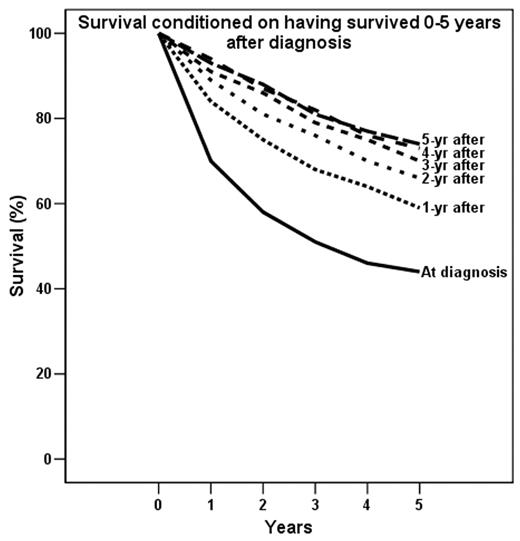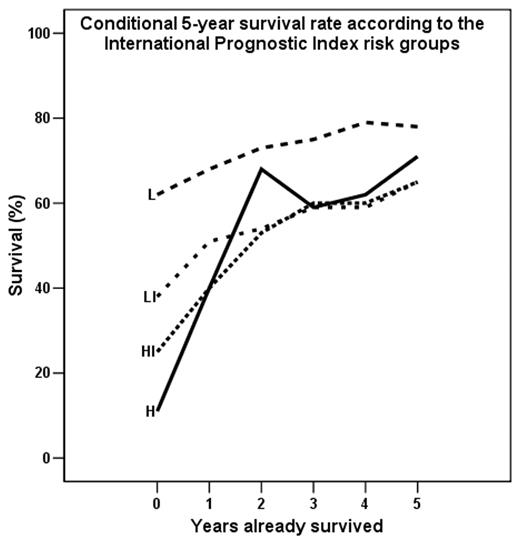Abstract
Purpose: Prognosis of lymphoma patients is usually estimated at the time of diagnosis, and the estimates are guided by the International Prognostic Index (IPI). However, survival rates calculated at the time of diagnosis may not be predictive of outcome for patients who have survived 1 or more years. For these patients conditional survival is more informative as only those patients who have already survived a period of time after treatment are considered. Conditional survival data have not been reported for lymphoma patients and the impact of the IPI on conditional survival is not known.
Patients and Methods: Conditional survival was estimated for 1,209 patients with diffuse large B-cell lymphoma from the population-based LYFO-registry of the Danish Lymphoma Group. The patients were diagnosed between 1983 and 1998 with a median follow-up time of 7.8 years, and all patients were treated with curative intent. The Kaplan-Meier method was used to estimate conditional survival at 0–5 years after diagnosis.
Results: The probability of surviving 5 years increased with each year survived for the first 3 years after diagnosis (from 43% to 70%) after which the increase was minimal (Figure 1). The median survival increased from 38 months for all patients to between 108 and 120 months conditioned on survival for at least 3 to 5 years. The distribution of patients in the IPI risk groups changed significantly over time. However this effect was only seen in the first 5 years. At diagnosis, 28% of the patients were allocated to the high-intermediate and high-risk groups, but only 11% of patients who survived 5 years were from these risk groups (P < .0001). Risk group allocation did not change the following 5 years (P = .7747). At the time of diagnosis overall survival differed greatly between the IPI risk groups (P < .0001; figure 2). However, 5 years after diagnosis the rates were similar (P = .0586). Furthermore, the prognostic impact of the individual clinical variables of the IPI (age, stage, performance score, LDH, and extranodal disease) was also significant at diagnosis, but 2 years after diagnosis only age had prognostic impact. Multivariate analysis (including the IPI and the individual IPI variables) of patients who survived ≥3 years identified only age as a prognostic factor (relative risk 4.1; P < .001).
Conclusion: For patients with diffuse large B-cell lymphoma who have survived more than 1 year after diagnosis, the conditional survival probability provides more accurate prognostic information than the conventional survival rate estimated from the time of diagnosis. Furthermore, age is the most important factor for long-term survival, whereas the remaining IPI factors are not informative.
Author notes
Corresponding author



This feature is available to Subscribers Only
Sign In or Create an Account Close Modal